Faced with issues such as frequency fluctuations in the power grid caused by a high proportion of new energy generation injection, there is an urgent need for a large amount of frequency regulation resources to maintain stable and safe operation of the power grid. However, traditional unit frequency regulation processes have complex responses and are difficult to cope with equipment wear and tear caused by frequent regulation of automatic generation control (AGC), making it difficult to meet the needs of the power grid. Energy storage systems are widely used in power systems due to their fast and precise control, large instantaneous throughput, and other characteristics, and can better meet the frequency regulation needs of the power grid. Among them, battery energy storage systems are often used for frequency control in power systems due to their excellent control performance. As of August 2021, China has introduced relevant policies to encourage energy storage as an independent carrier to participate in auxiliary services such as power grid frequency regulation. In addition, the National Development and Reform Commission, local governments, and the State Grid of China have successively issued multiple documents such as the “Guiding Opinions on Promoting the Healthy and Orderly Development of Electrochemical Energy Storage”, which clearly stipulate that the charging and discharging time for energy storage to participate in frequency regulation under rated power shall not be less than 15 minutes, and strengthen the development of energy storage batteries on the grid side and user side to meet the assessment indicators of the grid frequency regulation unit. With the continuous deepening of China’s electricity market reform, the variety of products that provide auxiliary services for battery energy storage system (EMS) to obtain economic benefits will also further increase, and energy storage technology will achieve further high-quality development.
The forms of energy storage system participation in frequency modulation mainly include direct participation in frequency modulation, auxiliary traditional unit frequency modulation, joint wind and solar energy frequency modulation, and other new energy frequency modulation. Under actual operating conditions, the combination of “traditional unit+energy storage” is currently commonly used. The energy storage system cooperates with traditional units to participate in auxiliary frequency regulation services, where the energy storage system is generally connected from the low-voltage side of the power plant. According to the current market rules in China, battery energy storage systems often use battery materials such as lithium-ion batteries, liquid flow batteries, and lead carbon batteries to assist traditional power frequency regulation. Among them, lithium iron phosphate batteries are often the first choice for energy storage frequency regulation due to their advantages of high energy, power density, long cycle life, mature technology, and relatively low cost. At present, a large number of lithium iron phosphate battery energy storage power stations in China have been put into operation, such as Hunan Langli 24 MW/48 MWh, Furong 26 MW/52 MWh, Yannong 10 MW/20 MWh energy storage power stations, and Laicheng Power Plant 9 MW/4.5 MWh energy storage combined units, widely used in fields such as new energy consumption, smooth fluctuations, and power system dispatch.
However, due to technological limitations, how to fully utilize existing energy storage to participate in frequency modulation is currently a hot research topic. To verify the fast regulation characteristics of the energy storage system, by introducing an energy storage system to assist traditional thermal power units in frequency regulation, the number of actions of thermal power units is significantly reduced, while meeting the assessment objectives of the power grid for frequency regulation units; However, there are many and complex types of energy storage, and the best application scenario needs to be selected. According to the working modes of power and energy, supercapacitor energy storage and battery energy storage systems are divided to meet the different characteristic power requirements of the power system; Based on adaptive filtering algorithm, adjust the response of demand signals between supercapacitors and battery energy storage stacks to leverage the fast response advantage of energy storage systems; In addition, by recording the charging and discharging status of the battery energy storage system during its cycle and conducting simulation, and verifying the proposed battery energy storage correction algorithm, it provides ideas for the subsequent participation of the battery energy storage system in automatic generation control.
In practical engineering, the frequency cannot always be maintained at the reference frequency state, and the frequency regulation capability of large-scale energy storage power plants is limited by the state of charge (SOC) of the energy storage unit. In the process of tracking frequency regulation commands, the power station needs to continuously switch between charging and discharging states according to relevant commands. In the long run, the energy storage system requires relatively small system capacity to respond to frequency fluctuations and achieve power up and down regulation, and the overall cost of participating in the energy storage system is relatively low. The capacity configuration of large-scale battery energy storage systems is flexible, and multiple time scale frequency modulation applications can be achieved based on the different needs of the system, including fault frequency modulation (nanosecond), primary frequency modulation (second level), secondary frequency modulation (minute level), and tertiary frequency modulation (hour level). The primary frequency modulation mainly faces random disturbances with fast change speed and small amplitude, while the secondary frequency modulation mainly faces minute level or longer cycle load disturbances, Third frequency regulation, also known as economic dispatch, is mainly aimed at power plants. In the face of significant disturbances in the power system, they complement each other and meet the frequency adjustment requirements of the system under different operating modes. However, in the face of the impact of large-scale new energy integration such as wind and solar on the frequency of the power grid, the mechanism of the impact of new energy on grid stability has not been thoroughly revealed, and it is difficult to determine the appropriate application scenarios for introducing battery energy storage systems. Therefore, it is urgent to study and develop relevant strategies to use energy storage resources to improve the frequency regulation ability of the system, in order to assist traditional power sources in improving AGC performance. Based on China’s relevant energy storage frequency regulation policies, this article analyzes and summarizes the current primary and secondary frequency regulation processes from the perspective of the working principle of battery energy storage systems to improve the frequency regulation performance of traditional units. Then, a detailed comparison is made between the virtual inertial control and virtual droop control of primary frequency regulation, and a control strategy model for the secondary frequency regulation process is proposed, in order to provide some reference for the development of China’s energy storage frequency regulation technology.
1.Primary frequency modulation
In China’s electricity auxiliary market, the unprofitable primary frequency regulation is a service that grid connected power stations must provide. Conventional primary frequency regulation refers to the use of inherent load frequency characteristics in the power grid and the combined action of generator sets with primary frequency regulation function. It is generally a mechanical device with rotating inertia, but the energy conversion process is more complex. The participation of energy storage in primary frequency regulation is often achieved by simulating the droop characteristics and inertial control of conventional units, as shown in Figure 1. The energy storage system sets the output time and action amplitude of the energy storage system based on frequency deviation values and dead zone limitations. Its control function is implemented locally by multiple power conversion systems (PCS). When the frequency deviation value exceeds the frequency regulation dead band, the energy storage system starts to operate and exchanges power with the power grid; When the frequency deviation value does not exceed the dead band range, the energy storage system stops operating to achieve the stability of the power grid frequency.
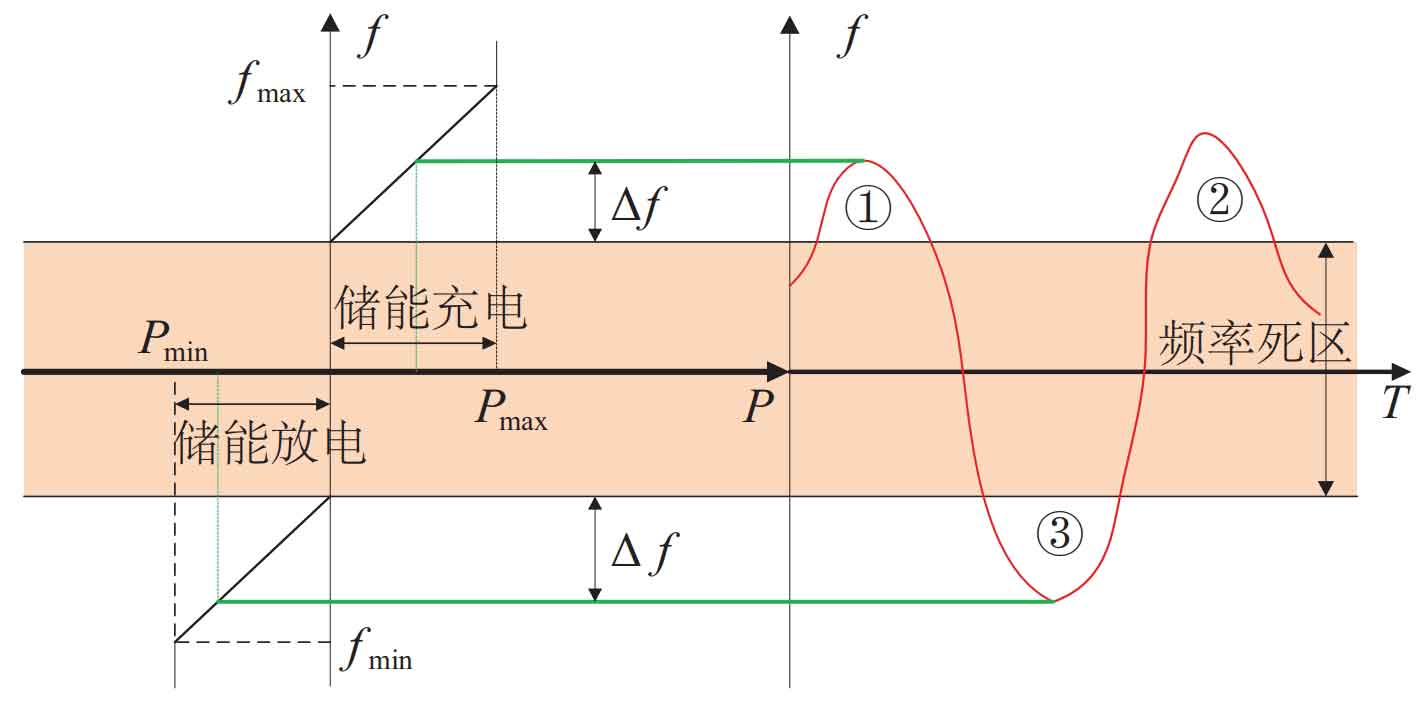
The dead zone refers to the area where the system is not sensitive to speed near the rated speed. When the frequency of the energy storage system exceeds the pre-set frequency dead band range, as shown in the ① and ② areas of Figure 1, the PCS charging mode absorbs active power, the energy storage system absorbs grid energy during charging, and the PCS in the ③ area releases active power. The energy storage system discharges to provide electricity to the grid. It is not difficult to see that in the droop characteristic, the traditional power supply adjusts the operating power according to the set unit to automatically respond to frequency changes. Unlike this, the energy storage virtual inertial control is that the kinetic energy stored in the traditional power supply’s rotational inertia can provide inertial support for the power grid, as shown in Figure 2 for comparison.
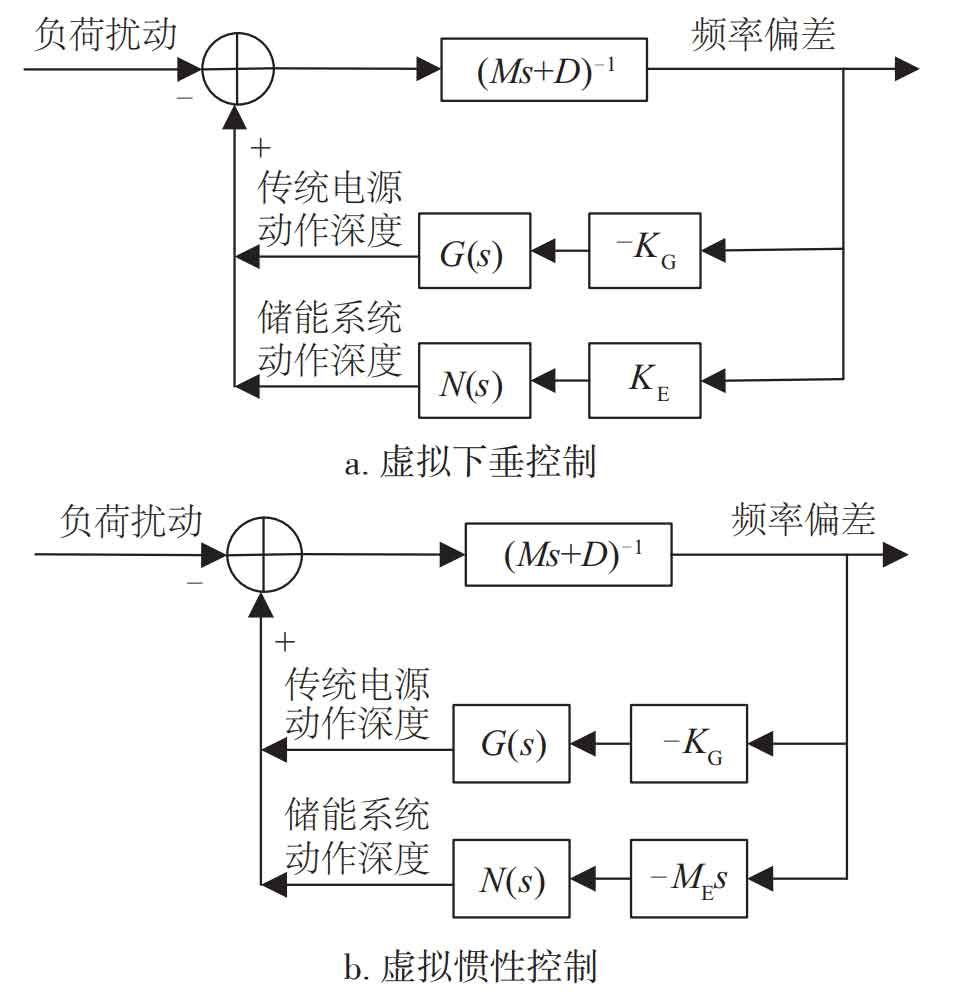
In Figure 2a, KE refers to the virtual unit regulated power of the energy storage system, and in Figure 2b, ME refers to the virtual inertia coefficient of the energy storage system; The parameter M is the inertia time constant of the power grid, D is the load damping coefficient, G (s) and KG respectively refer to the unit regulated power and transfer function of traditional power sources, and N (s) refers to the transfer function of the energy storage system. Overall, both virtual droop control and inertial control can improve the frequency deviation of energy storage systems. Sag control has a significant impact on steady-state frequency deviation, while inertial control, on the contrary, utilizes its own fast response characteristics to have a significant impact on the initial frequency difference conversion rate. Therefore, it is necessary to propose a comprehensive control mode that combines virtual droop control and virtual inertial control for the energy storage system, fully utilizing the fast and accurate characteristics of the energy storage system to improve the frequency regulation effect of the power grid. The schematic diagram of energy storage participating in the primary frequency regulation of the power grid is shown in Figure 3, where curves PL1 and PL2 are the power frequency characteristic curves at different power levels on the load side, and PG is the static power frequency characteristic curve on the power generation side.
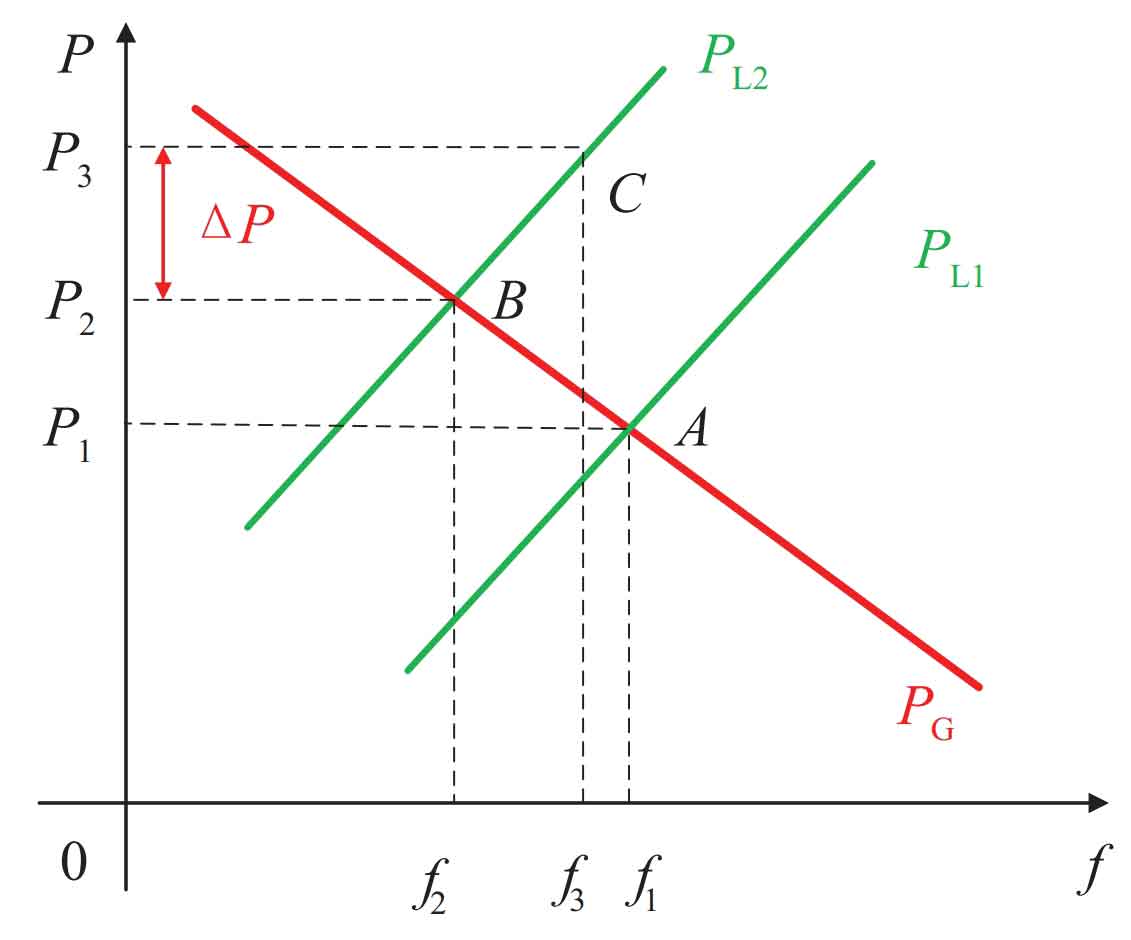
Assuming that the starting frequency of both the power generation and load sides is f1, intersecting at point A. If the disturbance on the load side suddenly increases and the active power output of the generator cannot suddenly change, resulting in a sudden decrease in rotor speed and a decrease in system frequency response, that is, the load curve PL1 moves up to PL2, the operating stability point moves from A to B, and the rated frequency drops to f2. According to the energy storage droop characteristic curve, at this time, the energy storage releases active power Δ P. The operating point moves from B to C, the frequency rises to f3, and the frequency deviation decreases, achieving energy storage frequency modulation function. However, in practical application scenarios, energy storage is more used to assist traditional unit frequency regulation, taking into account factors such as frequency deadband. The battery energy storage system monitors the frequency signal of the power grid in real time. When the frequency changes beyond the deadband, the accurate and fast adjustment characteristics of the battery energy storage system and the traditional unit primary frequency regulation performance are used together to quickly restore the frequency to the normal allowable range of the system. As shown in Figure 4, the power frequency curve PG on the same generation side initially intersects with the load curve PL1 at point A. As the load increases, PL1 moves to PL2, and the intersection point moves from A to B. The energy storage system releases power with a output of Δ P. The frequency rebounded to f3.
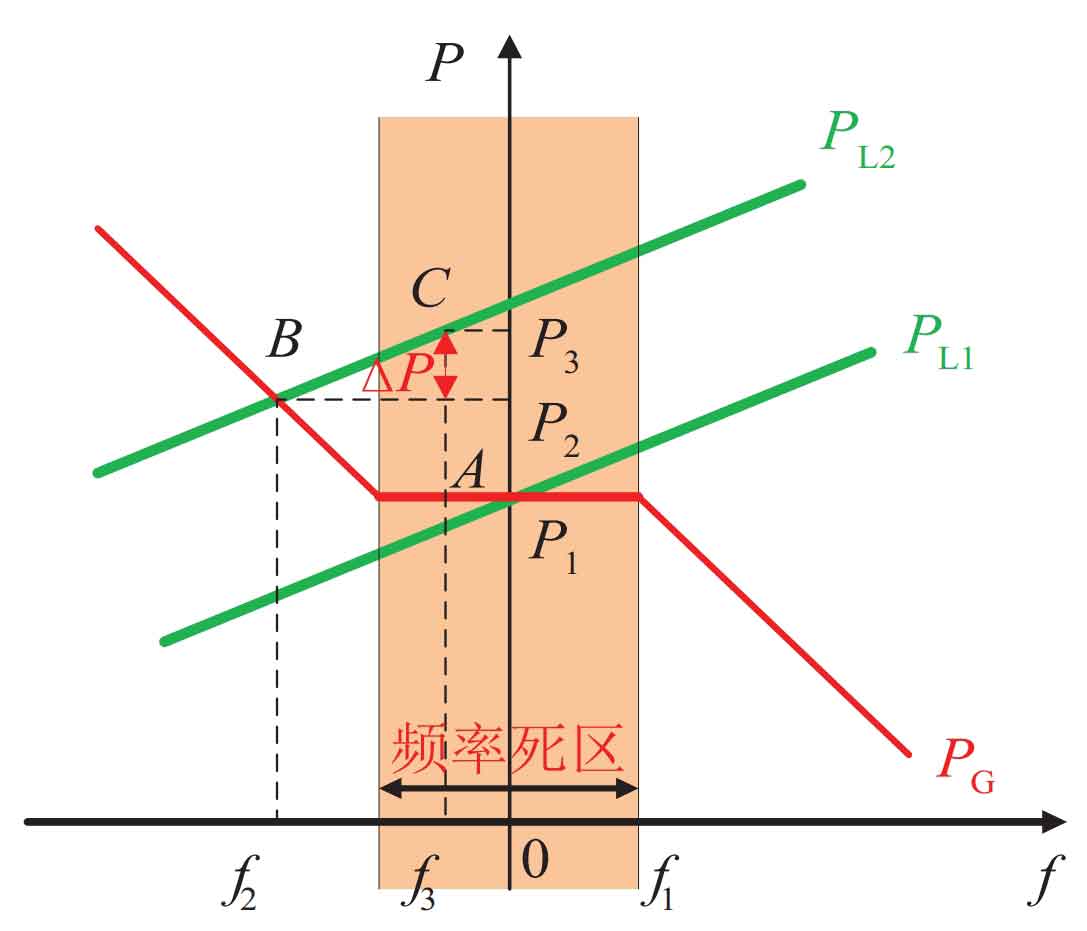
The process diagram of battery energy storage system assisted traditional primary frequency regulation is shown in Figure 5, and the principle is shown in equation (1):

In the formula: KS – comprehensive consideration coefficient; KG – Frequency regulation coefficient of traditional units; KL – Load frequency regulation coefficient; KB – Frequency regulation coefficient of battery energy storage system.
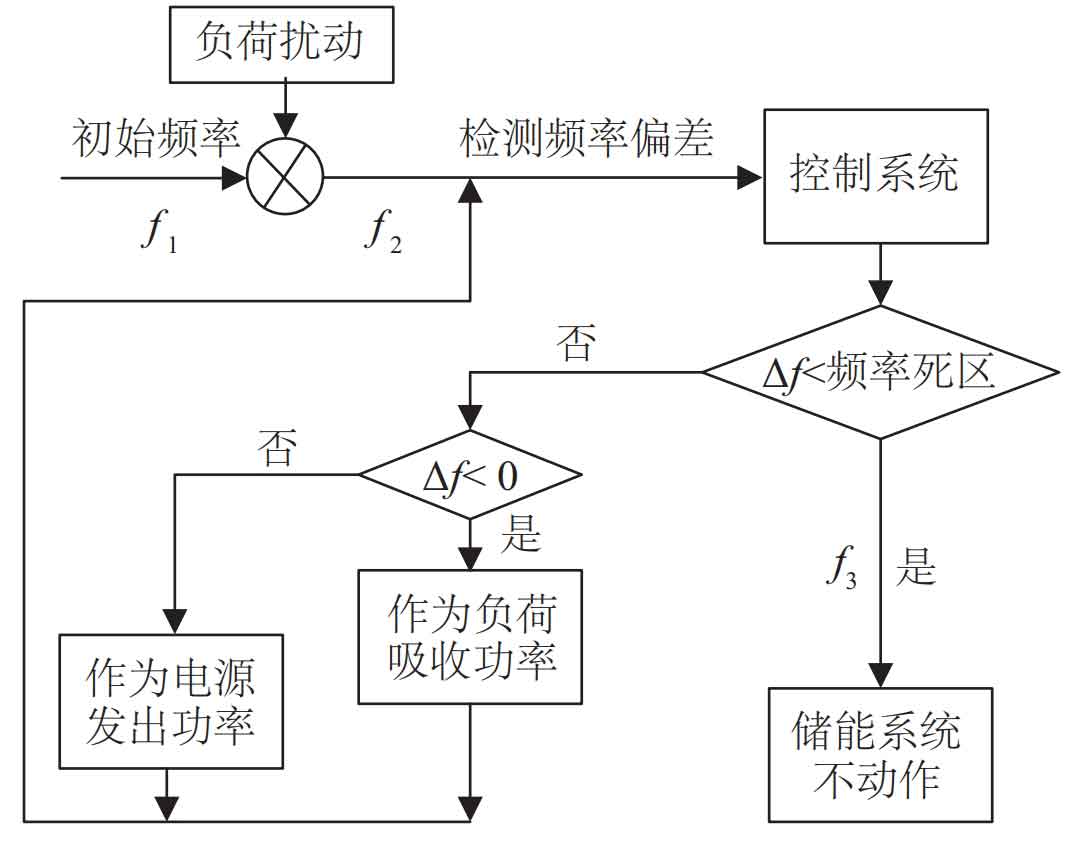
The battery energy storage system assisting traditional units with primary frequency regulation can effectively reduce the frequent actions of traditional units, reduce equipment wear, and compensate for the continuous frequency changes caused by the response delay of traditional units. However, under this control strategy, small fluctuations in the power grid lead to frequent charging and discharging of the energy storage system, affecting the service life of the battery and reducing its lifespan. Therefore, while studying primary frequency regulation, the State of Charge (SOC) of the battery is considered, and the principle of time-sharing and segmented control is adopted, as shown in Table 1 and Figure 6.
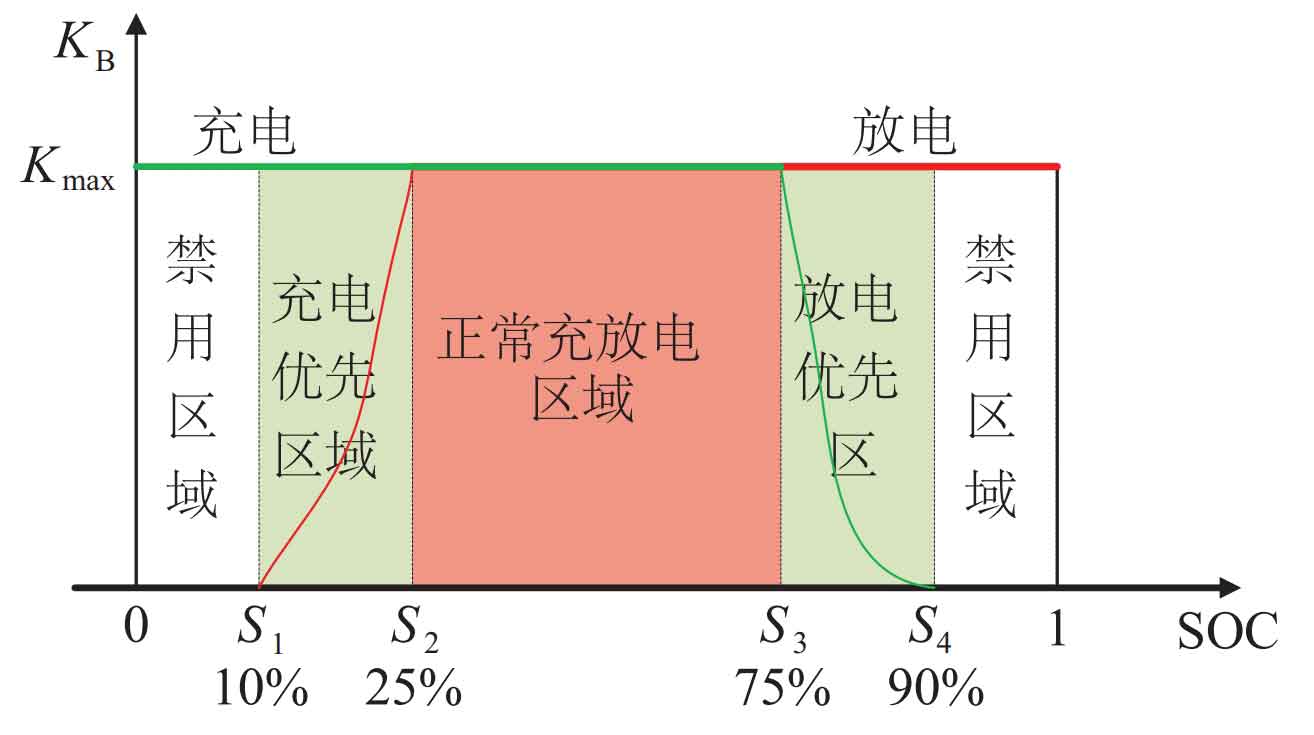
Among them, Kc represents the charging regulation power, Kf represents the battery discharge regulation power, S represents the battery state of charge (SOC), and in addition, the value of n is related to the frequency modulation effect. The higher the value of n, the weaker the frequency modulation effect. Based on Table 1 and Figure 6, it can be seen that when the SOC value is small and within the range of [S1, S2], that is, the battery level is low and needs to be charged; Within the range of [S2, S3], the battery has the best state, sufficient power, and can achieve high-power charging and discharging Within the range of S3 and S4, the battery level tends to saturate, which can ensure the frequency modulation effect of the battery energy storage system while ensuring the maximum service life of the battery.
| Section | Charging and discharging status |
| [S1, S2] | Mainly charge, reduce appropriately |
| [S2, S3] | Maximum unit power adjustment of discharge power |
| [S3, S4] | Mainly discharge, reduce charging power appropriately |
When the power grid has high requirements for transient frequency and traditional power sources are unable to meet the frequency regulation requirements, or when the power grid is in a peak load state and traditional power sources are at full capacity and unable to meet the capacity requirements, there may be problems such as the inability to restore the frequency to the normal range after primary frequency regulation. Further use of synchronizers or frequency regulators is needed, that is, to use the zero error characteristics of secondary frequency regulation to change the unit output and shift the power frequency characteristic curve. In addition, compared to the inherent primary frequency regulation characteristics of the speed regulation device of the generator set itself, introducing a battery energy storage system to participate in secondary frequency regulation has certain advantages, which can achieve precise adjustment through grid frequency deviation.
2. Secondary frequency modulation
At present, the assistance of energy storage systems to traditional unit secondary frequency regulation generally refers to the adjustment of AGC automatic setting through computer monitoring systems, mainly divided into distributed and centralized, to ensure accurate control and stability of power system frequency. Among them, centralized control mainly achieves zero error tracking and regulation of frequency through microgrids, but its reliability is relatively low; Distributed control, on the other hand, is based on consistency related algorithms and has low dependence on central control nodes, making it easy to expand and highly reliable. As for the auxiliary secondary frequency regulation of energy storage systems, decentralized layout and unified scheduling of battery energy storage systems are the main control methods currently adopted. Therefore, China’s power grid currently adopts partition control method. By calculating the area control error (ACE) signal and the area regulation requirement (ARR) signal, the signal is identified and transmitted to the energy storage station, where the frequency deviation is calculated and tracked for execution. After receiving the frequency modulation power command, EMS comprehensively considers the inconsistency of the charging state of the energy storage unit in the energy storage system, Develop relevant strategies and dispatch the energy storage system to participate in secondary frequency regulation, thereby reducing unit losses caused by frequent adjustments and meeting the assessment indicators of the power grid for frequency regulation units.
By comparing and analyzing the differences between ACE signal and ARR signal, and then smoothing based on fuzzy control theory; By establishing an AGC model and a simulation model of SOC size, a coordinated control strategy was developed, and the effectiveness of the strategy in multiple application scenarios was verified; To avoid the phenomenon of exceeding the limit in the actual working process of the energy storage system, a control strategy for switching the state of battery energy storage between charging and discharging mode and frequency modulation mode is proposed; Based on the empirical mode decomposition method, the frequency modulation demand signal is decomposed into multiple modal components, and the power command of the energy storage system is determined considering relevant constraints such as the response speed of the frequency modulation unit; Based on the discrete Fourier algorithm, the frequency modulation signal is decomposed into two types: low-frequency (traditional unit) and high-frequency (energy storage system), and relevant simulations are built to prove the superiority of the frequency modulation effect of the energy storage system; Based on PI regulation control, a control strategy for decentralized energy storage participating in power grid frequency regulation is proposed to ensure that the battery energy storage system does not exceed its limits during operation.
Due to the presence of the PI link during the transient process, the fast output characteristics of the energy storage system are partially limited by the ARR signal. From a system perspective, the ARR signal cannot effectively utilize the fast response characteristics of energy storage to optimize the response speed and climbing speed limitations of traditional conventional units, especially in maintaining SOC. The control method of the energy storage system based on ACE signal allocation does not go through the PI link, and cannot track the ACE signal according to the regulation requirements on the set time scale. Moreover, the output of the energy storage system is proportional to the ACE signal. Therefore, in assisting the secondary frequency regulation process of traditional units, the energy storage system determines the active power regulation amount by responding to the difference between the signal within the ACE dead zone and the frequency regulation output of traditional units, Output power to compensate for the output of traditional units can reduce the output of conventional units and frequency deviation under large disturbances, maintaining system frequency stability. As shown in Figure 7.
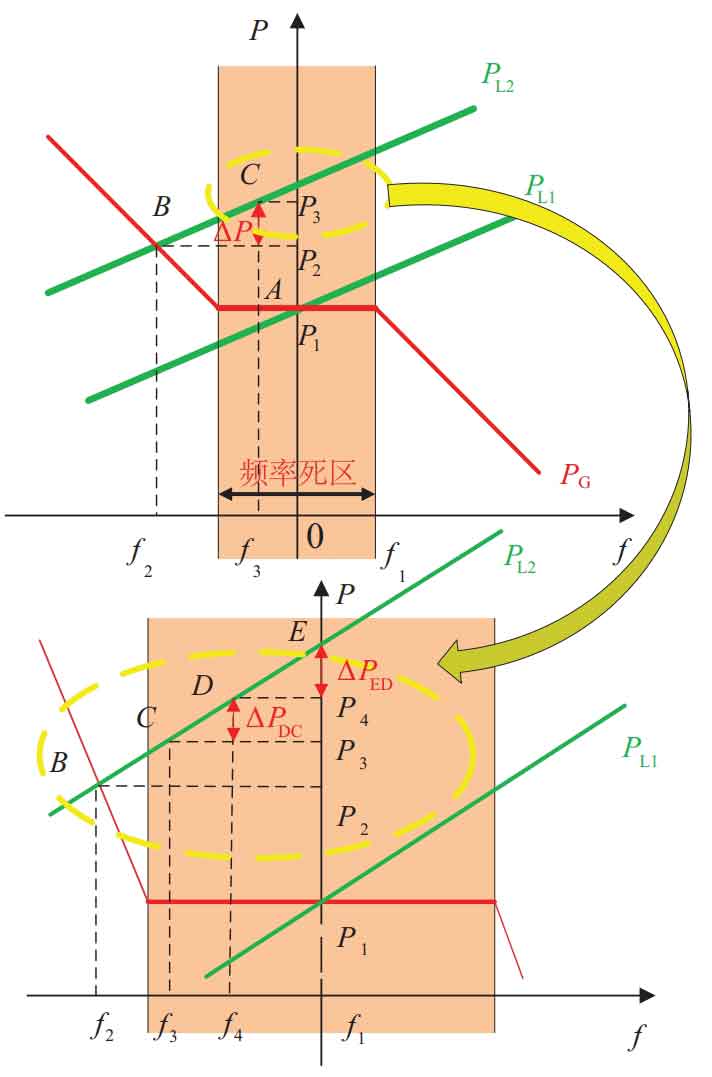
Therefore, secondary frequency regulation can respond to grid frequency fluctuations caused by long-term load power changes in new energy sources such as wind and solar power through AGC scheduling instructions. Based on Figure 4, after the completion of primary frequency regulation, the stable operating point moves from point A to point C, and then traditional units perform secondary frequency regulation to increase output Δ PDC, running from point C to point D, with frequency restored to f4. If this point is within the ACE frequency modulation dead band range, the traditional unit output stops and the remaining required power Δ PED is provided by the energy storage system to restore the system frequency to the rated value f1, thereby achieving zero difference adjustment of frequency. In addition, large-scale battery energy storage power stations are affected by the remaining capacity of batteries and the state of charge (SOC) during the process of assisting traditional unit secondary frequency regulation. Long term charging/discharging will cause the energy storage batteries to be in a saturated/depleted state, that is, in a battery disabled area for a long time. In this state, only unidirectional frequency regulation can be carried out, greatly weakening the ability of the energy storage system to participate in frequency regulation. Therefore, it is necessary to fully utilize the fast and accurate auxiliary frequency regulation of battery energy storage systems, as well as the differential characteristics of traditional unit frequency regulation with large capacity, and develop reasonable control strategies based on the power requirements of frequency regulation. In general, the control center formulates relevant control power allocation strategies by comprehensively judging the size of ACE, that is, dividing control according to three intervals [32]: dead zone, normal regulation zone, and emergency regulation zone, as shown in Table 2.
| Frequency modulation demand range | Feature |
| Emergency regulation area | Reduce ACE and restore FM demand to normal control zone |
| Normal regulatory zone | The reserve for participating in the secondary frequency modulation power supply is relatively abundant and the ACE is relatively small, coordinating the distribution of power demand |
| Adjusting Deadband | No longer adjusting the power reference values of each frequency modulation unit, restore the energy storage SOC to the ideal working range, and prepare for the next stage of participating in secondary frequency modulation services |
The control and dispatch center needs to develop relevant strategies based on the secondary frequency modulation power demand and state of charge, and convert these strategies into power instructions to be issued to the energy storage power station. To ensure that the SOC of each energy storage unit is in the normal discharge area, the energy storage system and the power station need to quickly coordinate the output situation of each unit to achieve the goal of frequency modulation power tracking. The specific process is shown in Figure 8.
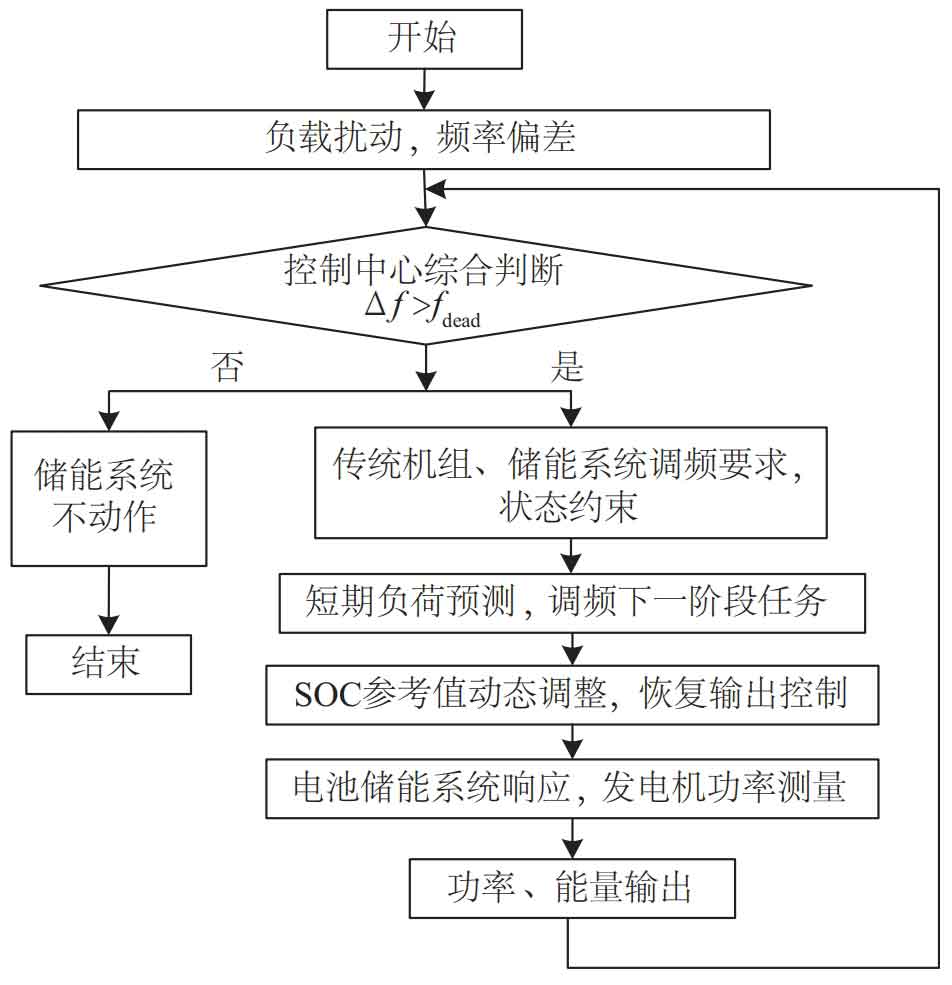
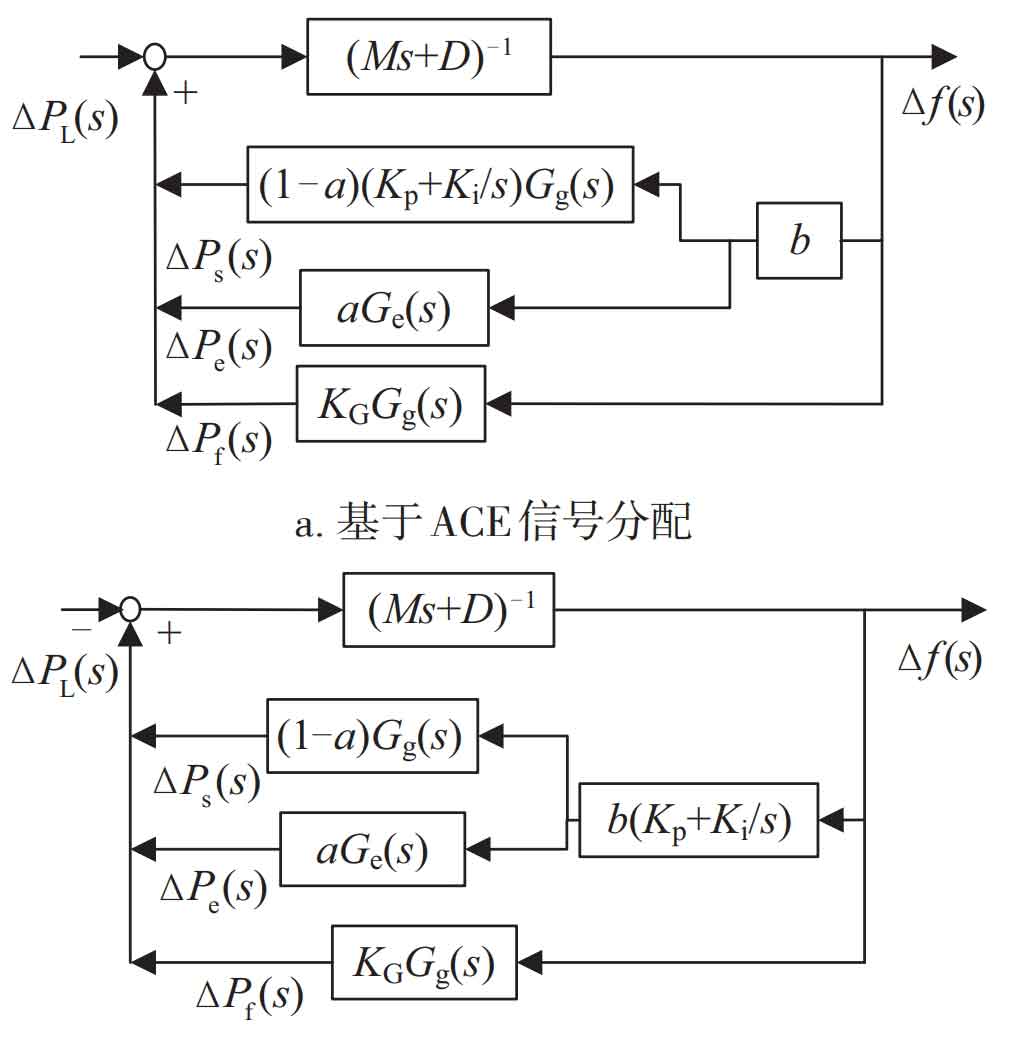
The control center distributes power based on ARR or ACE signals, as shown in Figure 9 for comparison. Among them, a is the secondary frequency regulation participation factor of the energy storage system, 1-a is the secondary frequency regulation participation factor of the traditional unit, b, Kp, and Ki are the frequency deviation coefficient of the traditional unit, the proportional controller coefficient of the PI controller, and the integral controller coefficient, respectively. Gg (s) and Ge (s) are the transfer function models of the traditional unit and the energy storage system, and (Ms+D) -1 is the machine network interface model, Δ PL (s) Δ F (s) are the load disturbance and frequency deviation, respectively, Δ Pe (s) is the action depth of the energy storage system, Δ Pf (s) and Δ Ps (s) represent the action depth of traditional units participating in primary and secondary frequency regulation. To avoid the delay effect of the PI controller, the output of the energy storage system varies with frequency deviation during the transient process. Therefore, when the same disturbance occurs, the output of the energy storage system with the ACE signal decreases compared to the ARR signal, while the traditional unit action increases; In the steady-state process, the traditional unit’s secondary frequency regulation ultimately compensates for all load increments, reducing the output of the energy storage system to zero. The simulation of the comparative output situation is shown in Figure 10, where four curves represent the energy storage system based on ACE and ARR signals, as well as the depth of traditional unit participation in frequency regulation action. It is not difficult to find that the energy storage under ACE signals and the release of energy equivalent to ARR signals by traditional units can achieve better frequency regulation effects, highlighting the advantages of ACE signals in improving transient frequency deviation and ARR signals in improving steady-state frequency deviation.
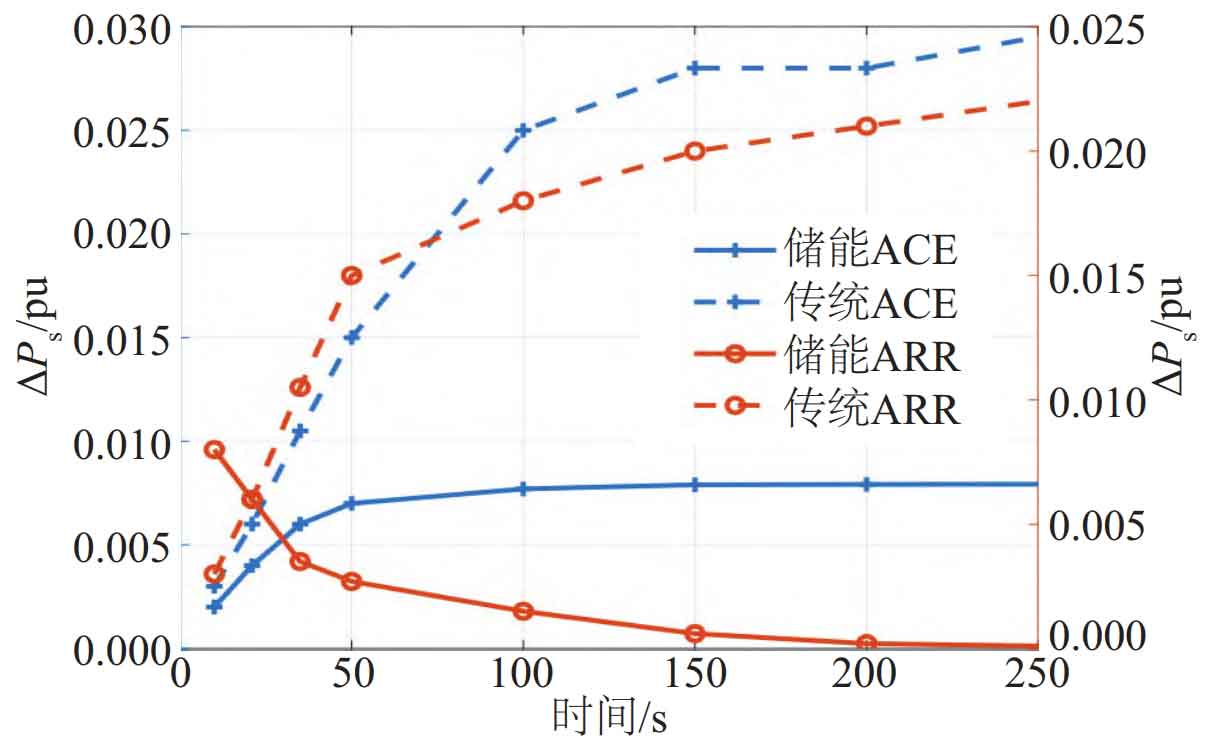
During the operation of a battery energy storage system, in addition to considering the SOC constraints of the state of charge, the state of power (SOP) of the battery can provide a specified operating range for voltage and current output and input, ensuring safe, stable, and economical operation of the battery. However, in the actual operation process of the energy storage system, for units with poor performance in the power stage with long duration and large deviation, continuous output is required to compensate for the deviation. However, continuous output can easily lead to the energy storage system being in a low battery disabled area, and overall, the overall efficiency of the energy storage system will decrease. So in the process of formulating the output of energy storage power plants, while considering the real-time tracking effect of joint output, it is also necessary to strictly control the charging state of energy storage units and find their equilibrium points. For the convenience of energy storage scheduling center management, energy storage compensation can be introduced δ ∈ [0,1], when δ = At 0, the energy storage system does not respond; When δ = At 1 hour, the energy storage system is fully compensated. At an appropriate compensation level, set the energy storage output command at time t in real-time, flexibly compensate for the real-time deviation of the unit tracking command, and establish a secondary frequency regulation control strategy for energy storage as follows:

At the same time, it is necessary to meet the maximum charging and discharging power constraint:

To avoid SOC exceeding the limit after energy storage is charged and discharged according to the compensation degree, it is necessary to set an energy constraint. During the charging process:

During discharge:

In the equation: δ —— Compensation degree for real-time deviation of energy storage system; PA (t) – AGC command power value at time t, MW; PG (t) – Actual output of the unit at time t, MW; SL, SH – The upper and lower limits of the SOC of the battery energy storage system.
However, in order to improve the balance between frequency regulation performance and the state of charge (SOC) of energy storage, real-time optimization of energy storage compensation is necessary. It is necessary to combine energy storage with traditional units to output frequency regulation, and use the joint output performance index f1 and operating condition balance f2 as the objective functions to measure the regulation performance while managing electricity. The optimization results of compensation should strive to achieve the maximum value of both. The objective function for establishing a model of energy storage participating in AGC frequency modulation strategy is:

In the formula: a3- corresponding indicator weight, all of which are 1/3, and the value range of each indicator is [0,1]; Ds, rs, ps – response delay, adjustment rate, and adjustment accuracy; Ecmax, Edmax – maximum charging and discharging capacity of the energy storage system; A1, a2, Erase – rated capacity of the battery energy storage system; F1- Joint frequency modulation performance index during the action cycle, and the larger f1 ∈ [0,1], the better the comprehensive frequency modulation performance index; F2- Balance of energy storage capacity, that is, the balance between the rechargeable and dischargeable capacity of the energy storage system, and f2 ∈ [0,1], the larger its value, the more balanced the bidirectional operation of the energy storage system.
However, due to the certain loss issues in the actual charging and discharging process of the energy storage system, when the energy storage system participates in assisting traditional unit frequency regulation for a certain period of time to t, the power PadBES (t) of the battery energy storage system is determined, and the real-time SOC changes of the energy storage system in the charging state are determined based on the charging and discharging time.

In the formula: tc, td – the charging and discharging time of the energy storage system; η C η D – The charging and discharging efficiency of the energy storage system.
During the participation of the energy storage system in the secondary frequency regulation process, it is not necessary to solely consider the power grid frequency regulation demand. It is necessary to adaptively limit the charging and discharging power based on the real-time state of charge of the battery, maintain the normal charging and discharging area of the energy storage battery, and then implement compensation for the energy storage system to solve the real-time operation strategy, that is, to achieve multi-objective optimization during the frequency regulation process, Establishing and improving an optimization operation strategy model for the energy storage system to participate in the optimal application scenario of secondary frequency regulation, and combining the advantages and disadvantages of control algorithms such as genetic algorithm, multi-objective particle swarm optimization algorithm, and fuzzy logic algorithm, will lay the foundation for capacity configuration and economic evaluation in the energy storage system frequency regulation application process. This will be the next research direction and focus.
3. Conclusion
Battery energy storage system is one of the mainstream technologies for electrochemical energy storage, which has broad application potential in multiple fields such as power generation, grid, and user sides. Especially on the grid side, it can assist traditional unit frequency regulation to solve problems such as grid fluctuations. However, in promoting the engineering application research of energy storage frequency modulation, it is urgent to effectively combine frequency modulation indicators with the fast response characteristics of battery energy storage systems to reduce the power and capacity requirements of energy storage batteries; In addition, the energy storage battery model is relatively simple and does not analyze how to participate in the frequency modulation process from the perspective of battery mechanism. Therefore, the following points need to be considered:
1) Establish a reasonable scheduling strategy, comprehensively consider the comprehensive load characteristics of the power grid affected by the volatility and uncertainty of new energy access, combine technical indicators such as energy storage loss and frequency compensation, balance the output situation of traditional units and energy storage systems, reduce the frequency regulation pressure of traditional units, and avoid overcharging and discharging of energy storage systems. Study the application scenario division of battery energy storage systems participating in power grid frequency regulation.
2) Considering the aging and loss issues of battery energy storage systems during use, establish a simulation model for energy storage batteries for grid frequency regulation, consider and design the action timing and control strategy of energy storage batteries, and use database and visualization software technology to develop energy storage participation in frequency regulation auxiliary decision-making analysis software, providing scheme selection for the optimal target capacity configuration.
3) Consider the coordinated control and operational mechanism of battery energy storage systems participating in power grid frequency regulation, quantify the benefits of battery energy storage systems participating in frequency regulation, and form a comprehensive technical and economic evaluation model to adapt to the economic issues of frequency regulation compensation price differences caused by different frequency regulation performance indicators, in order to provide reference for energy storage investment issues.
